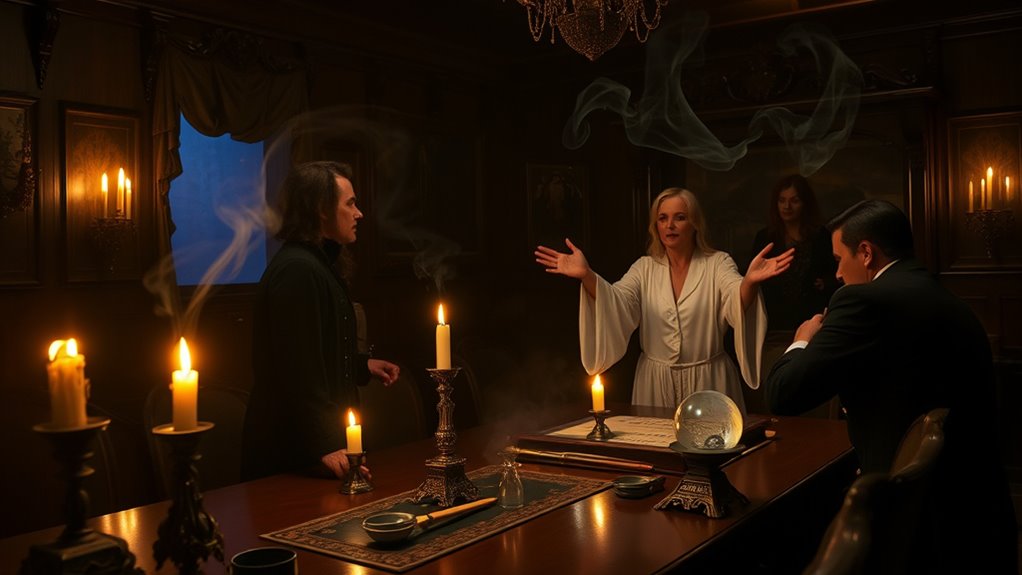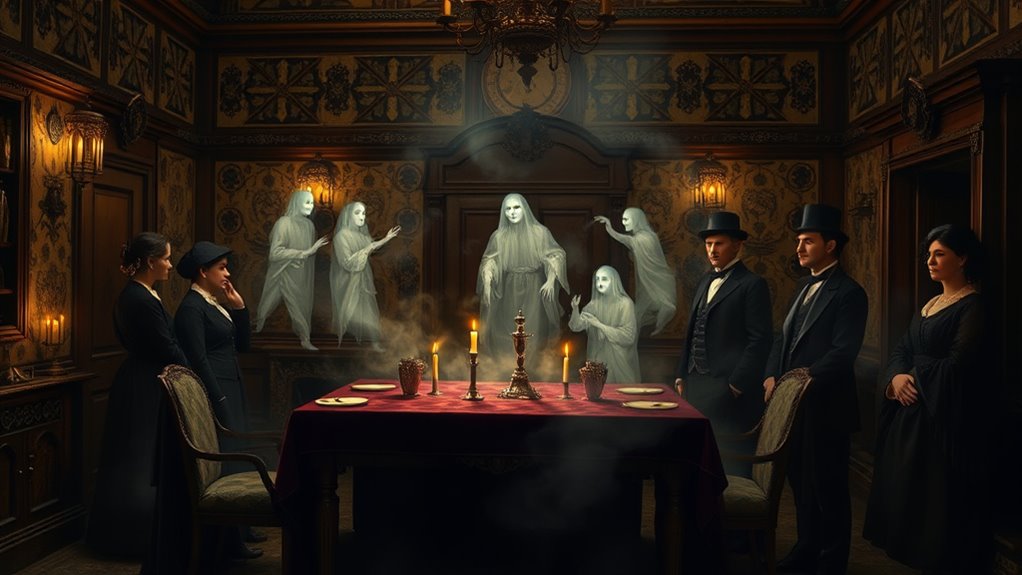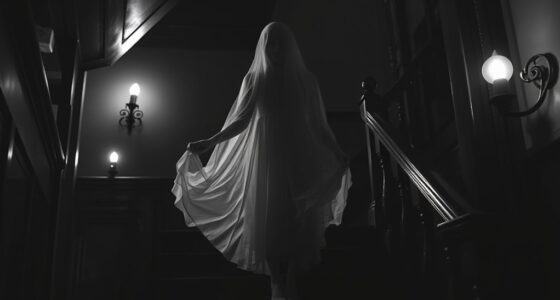In the 19th century, spiritualism grew as people sought to connect with spirits amid societal changes and scientific discoveries challenging traditional beliefs. You’ll find that practices like séances and mediumship became popular ways to explore the afterlife, offering comfort during times of loss. Influenced by Victorian values and curiosity about unseen worlds, this movement shaped arts, science, and social life. Continue exploring to uncover how this fascinating era’s beliefs shaped our history.
Key Takeaways
- Spiritualism surged in the 19th century due to societal interest in connecting with the afterlife amid cultural shifts.
- Techniques like automatic writing and séances made mediumship accessible and popular in social settings.
- Scientific discoveries challenged religious views, prompting exploration of spiritual phenomena as alternatives.
- The movement’s theatrical practices and personal testimonies sustained public belief despite skepticism.
- Spiritualism influenced art, literature, and science, reflecting broader societal efforts to understand life beyond death.

In the 19th century, spiritualism gained remarkable popularity as people sought to connect with the afterlife and explore the mysteries of the unseen world. During this period, many believed that spirits of the deceased could communicate with the living, and you might have found yourself intrigued by the various mediumship practices that emerged. These practices, often performed in séances or private settings, involved mediums acting as conduits between the living and the dead. They claimed to receive messages, images, or sounds from spirits, providing comfort and closure to those grieving. The Victorian era beliefs heavily influenced this surge in spiritualist activities, emphasizing the importance of spiritualism as a way to bridge the gap between the material and spiritual worlds. You’d notice that mediums often employed specific techniques such as automatic writing, trance states, or table-turning to facilitate communication. These methods became popular social activities, especially among women, who found empowerment and purpose through their roles as mediums. Many of these practices were rooted in a desire for reassurance amid the rapid changes of the time, including scientific discoveries and technological advances that challenged traditional religious views. People started questioning the dogma of organized religion, and spiritualism provided an alternative way to explore life’s mysteries. Additionally, the scientific curiosity of the era led some to investigate these phenomena with a scientific lens, attempting to validate or disprove their authenticity. The Victorian era’s beliefs played a significant role in shaping the acceptability of spiritualist practices. Society was captivated by the idea that the soul persisted beyond death and that spiritual communication could be scientifically studied. Spiritualist organizations and publications flourished, creating a sense of community among believers. You might have attended séances hosted in private homes or public halls, where mediums demonstrated their abilities and shared messages from loved ones. These gatherings often had a theatrical quality, blending entertainment with genuine belief. Many skeptics, however, questioned the authenticity of these practices, suspecting trickery or deception. Nonetheless, the popularity persisted, fueled by reports of successful messages and personal experiences. The rise of spiritualism during this time also inspired a broader cultural shift, influencing art, literature, and even scientific inquiry. As you explore this era, you’ll see that the fascination with communicating with spirits reflected deeper human concerns about mortality, loss, and the possibility of an ongoing existence beyond physical death. Overall, spiritualism in the Victorian era served as both a spiritual movement and a social phenomenon that left a lasting mark on history.
Frequently Asked Questions
How Did Spiritualism Influence 19th-Century Scientific Communities?
You notice that spiritualism influenced 19th-century scientific communities by sparking interest in psychic research, pushing scientists to explore phenomena like telepathy and clairvoyance. While some researchers embraced these ideas, many expressed scientific skepticism, questioning the validity of spiritualist claims. This debate led to more rigorous testing and the development of experimental methods, ultimately shaping the relationship between science and spiritualist practices during that era.
What Role Did Women Play in the Spiritualist Movement?
Did you know that women made up about 70% of spiritualist practitioners? You’ll find that female mediums played a central role, often demonstrating remarkable psychic abilities. Women organizers also led many spiritualist societies, shaping the movement’s growth. Their active participation challenged traditional gender roles, empowering women to speak publicly and assert influence in a chiefly male society, thereby fostering social change through spiritualism’s rise.
Were There Notable Controversies or Scandals Tied to Spiritualist Practices?
You’ll find that many controversies surrounded spiritualist practices, especially accusations of spiritualist fraud and mediumship deception. Notable scandals emerged when skeptics exposed supposed mediums faking communication with spirits, undermining trust. These scandals often involved elaborate tricks or hidden apparatus, leading to widespread skepticism. Despite these controversies, spiritualism persisted, but these scandals substantially shaped public perception and prompted calls for greater transparency in spiritualist demonstrations.
How Did Spiritualism Impact Religious Institutions of the Time?
Spiritualism’s surge shook religious institutions like a thunderclap, challenging their authority and doctrines. You’d see church resistance grow as spiritualists questioned traditional teachings, sparking doctrinal challenges that threatened their influence. This movement forced churches to confront new ideas about life after death and communication with spirits, ultimately prompting some to adapt or reaffirm their beliefs, while others faced declining congregations due to the shifting spiritual landscape.
What Were the Most Common Methods Used in Spiritualist Séances?
During spiritualist séances, you often see table turning experiments where you and others gently move a table to communicate with spirits. Spirit photography is also common, capturing images of supposed spirits alongside living subjects. These methods aimed to prove the existence of spirits, making séances intriguing and convincing. Participants believed these techniques provided direct contact with the supernatural, fueling the growth of spiritualism in the 19th century.
Conclusion
So, as you’ve seen, the 19th century’s spiritualist movement thrived on the hope of connecting beyond death, yet it often left believers questioning what was real. Ironically, in seeking proof of the afterlife, many found themselves more convinced of deception than divine truth. Maybe, in the end, the true spirit of spiritualism was less about spirits and more about human longing — a reminder that sometimes, we’re more enthusiastic for answers than the truth itself.









